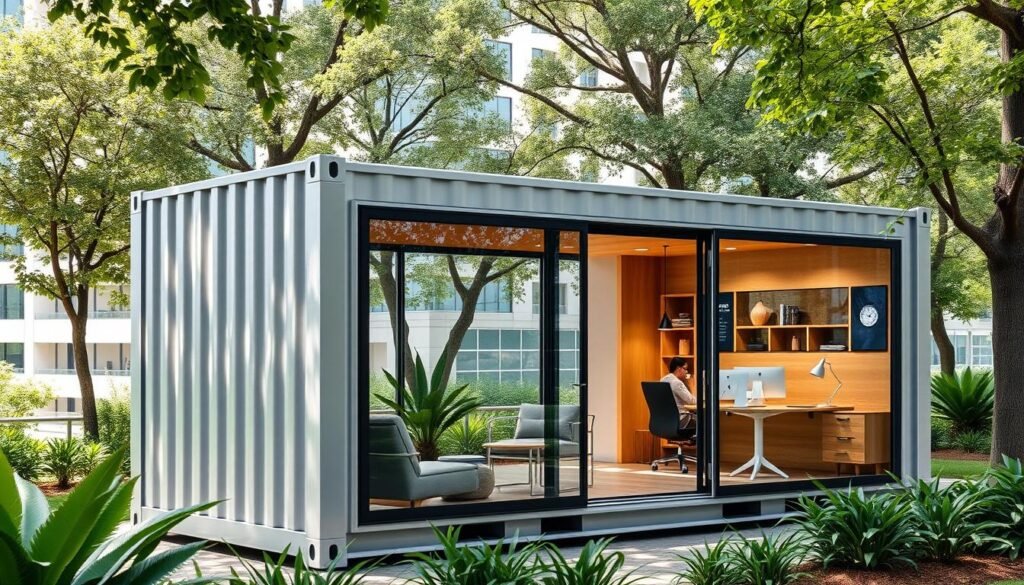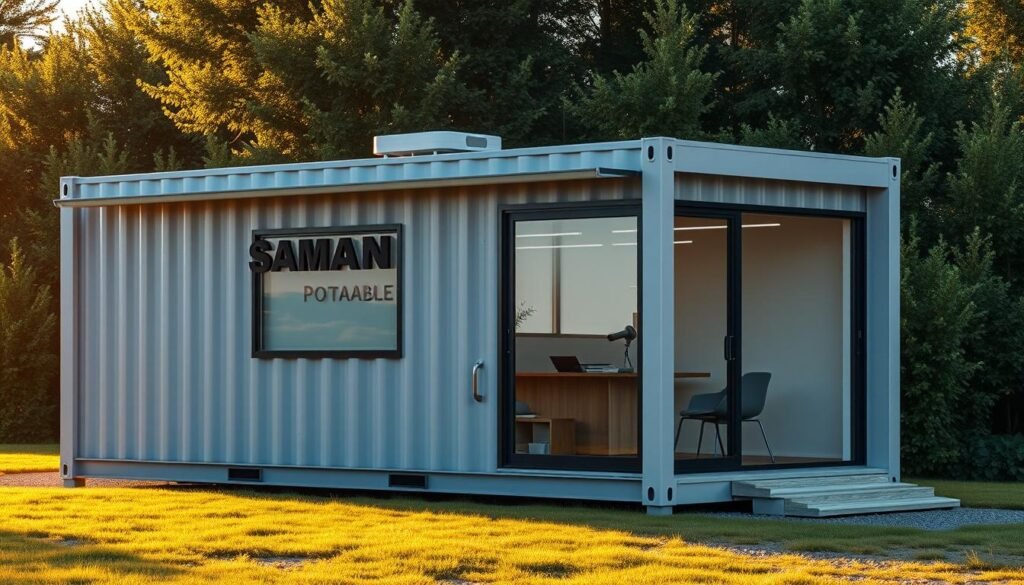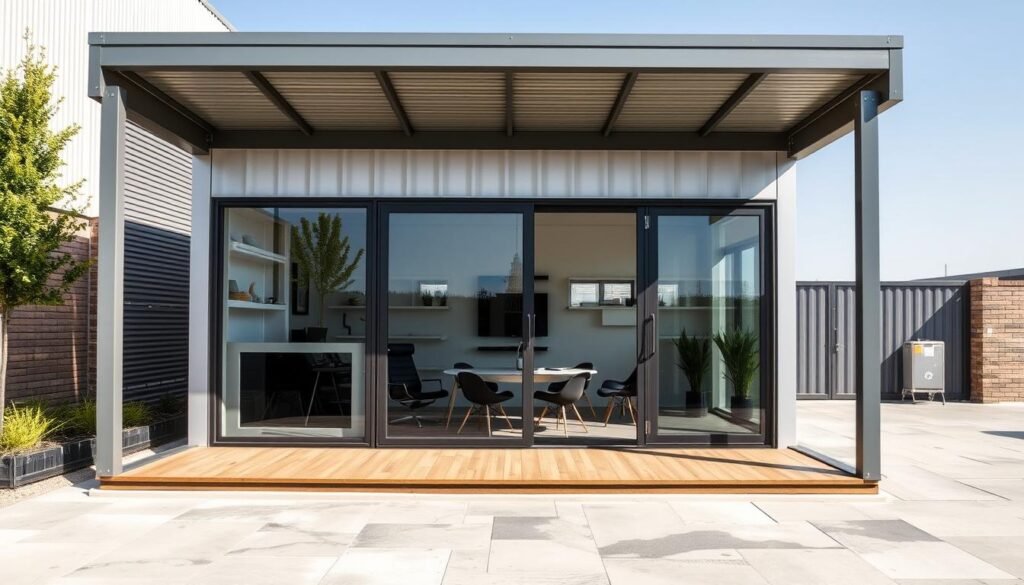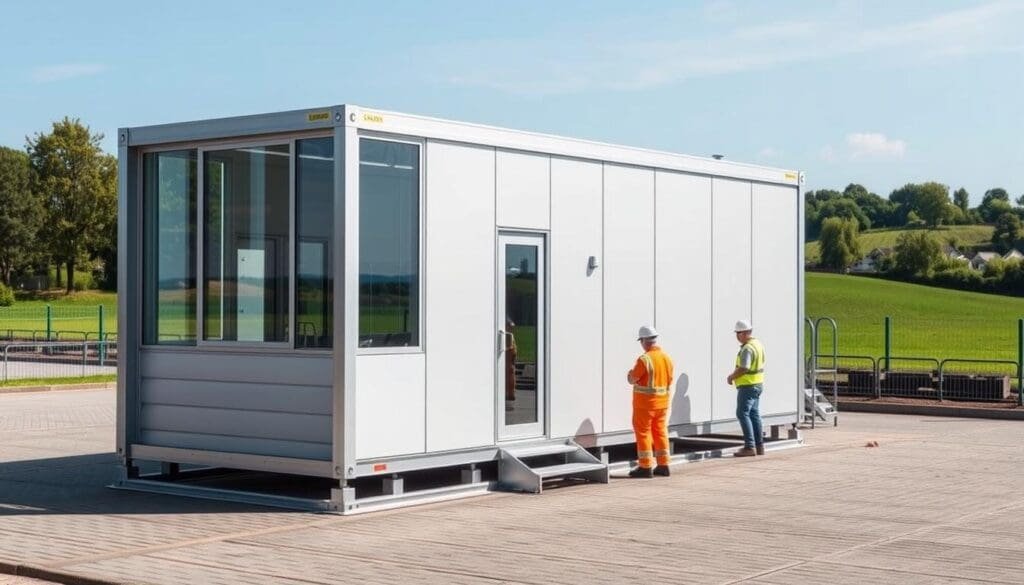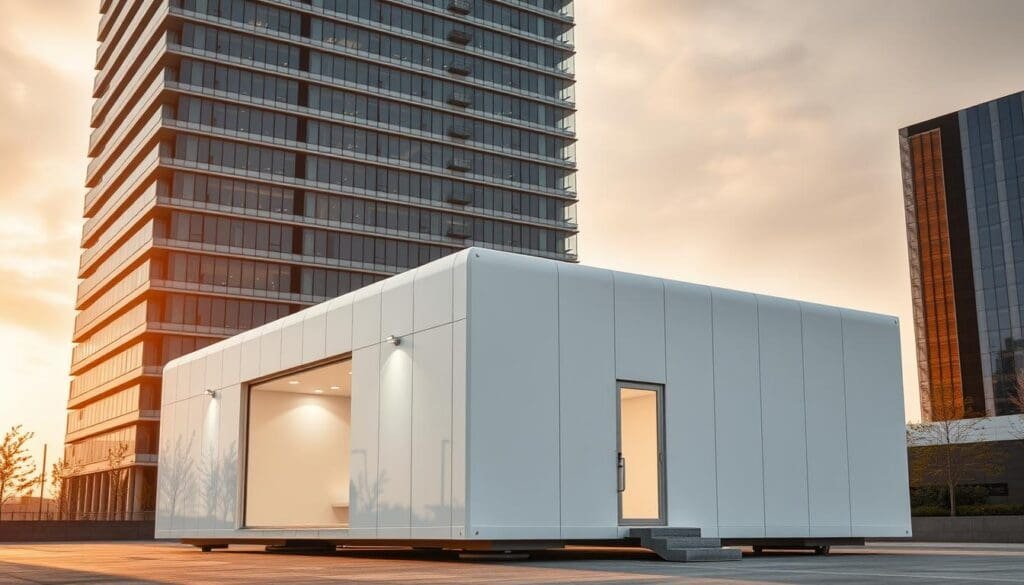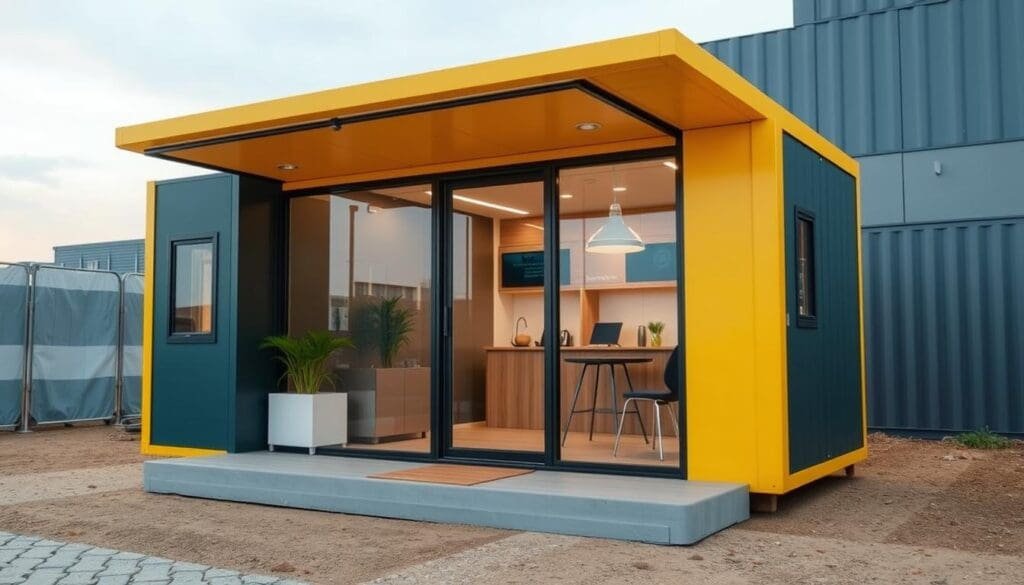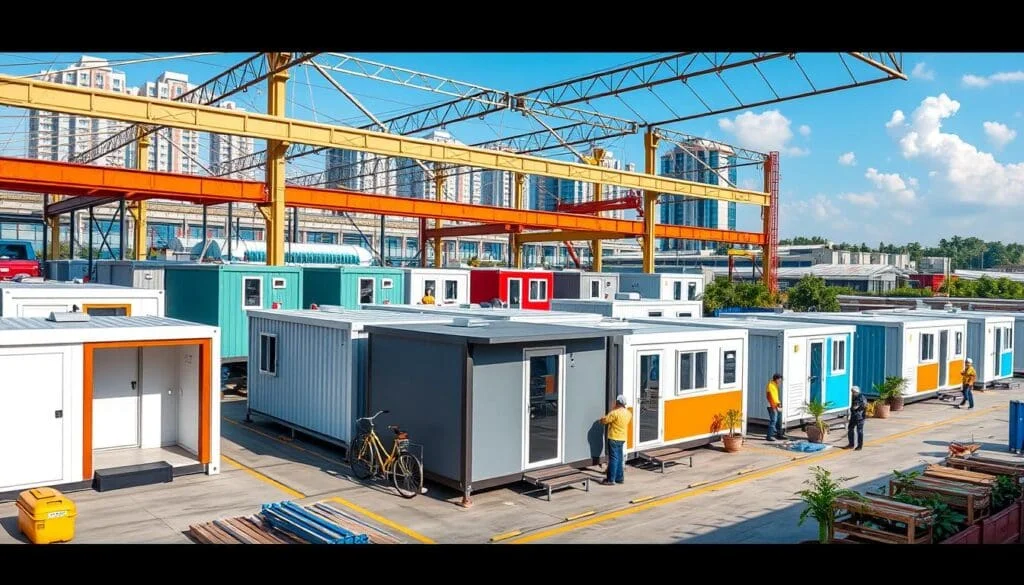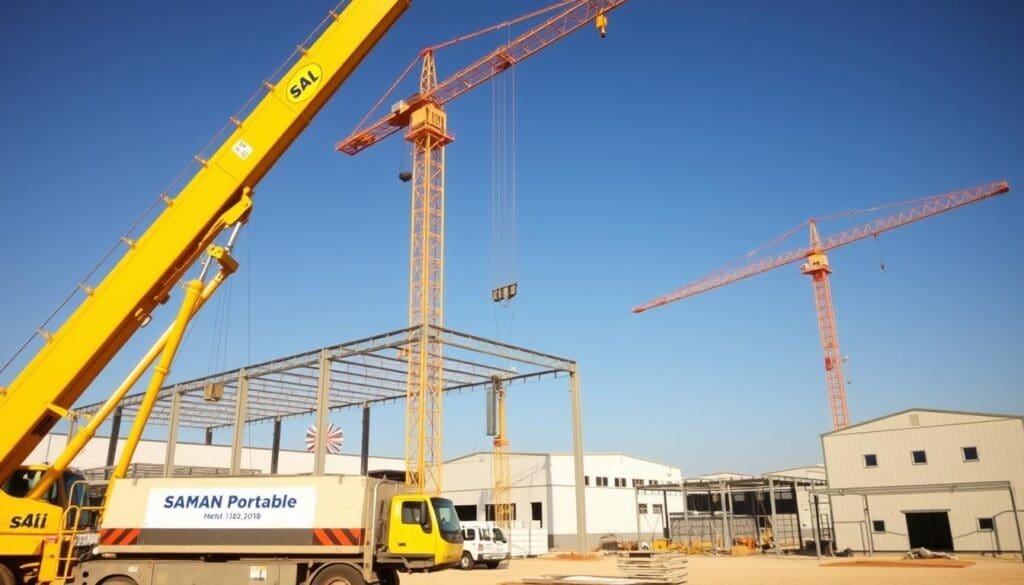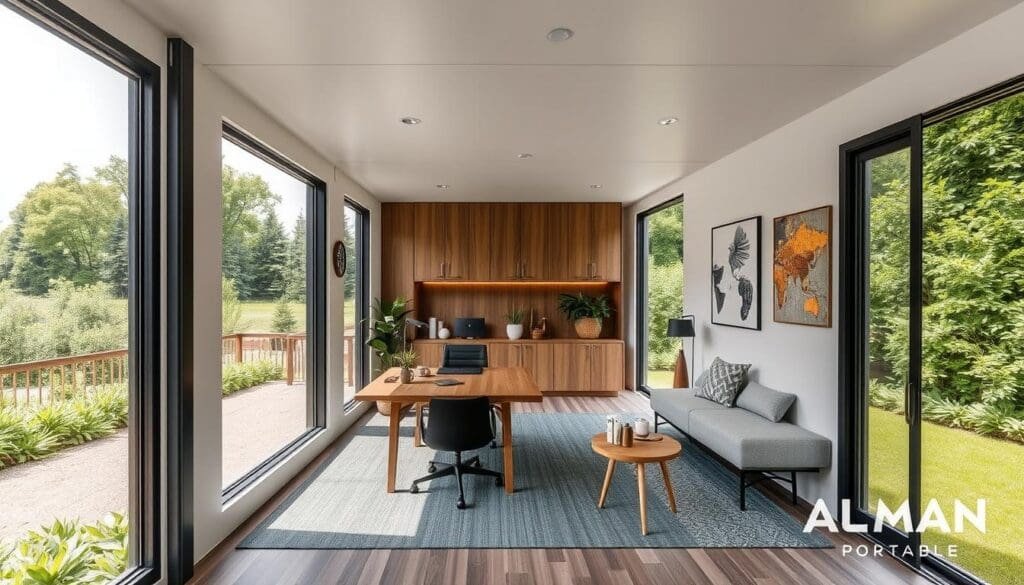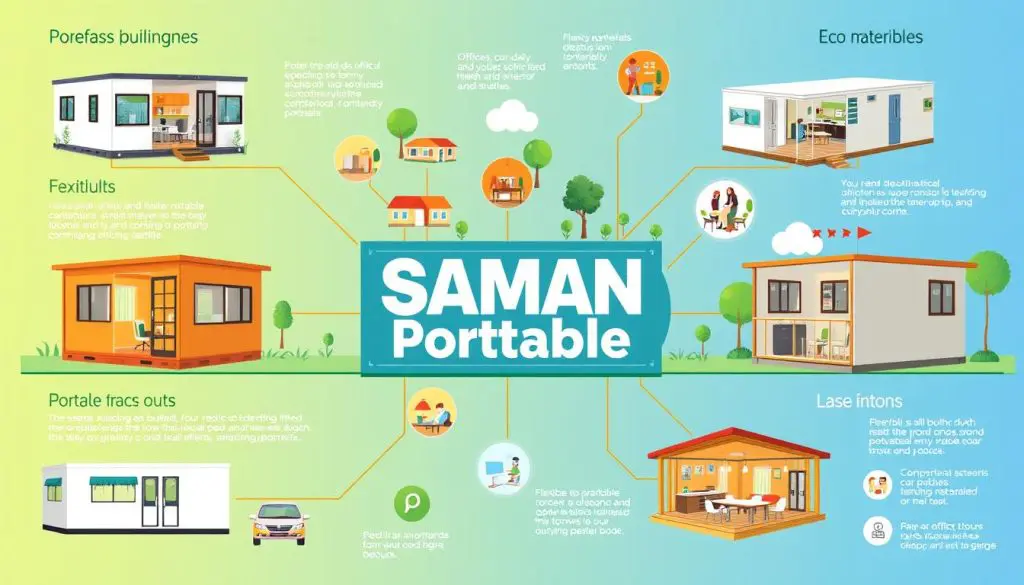Porta Cabin Costs: A Comprehensive Guide to Pricing in 2024
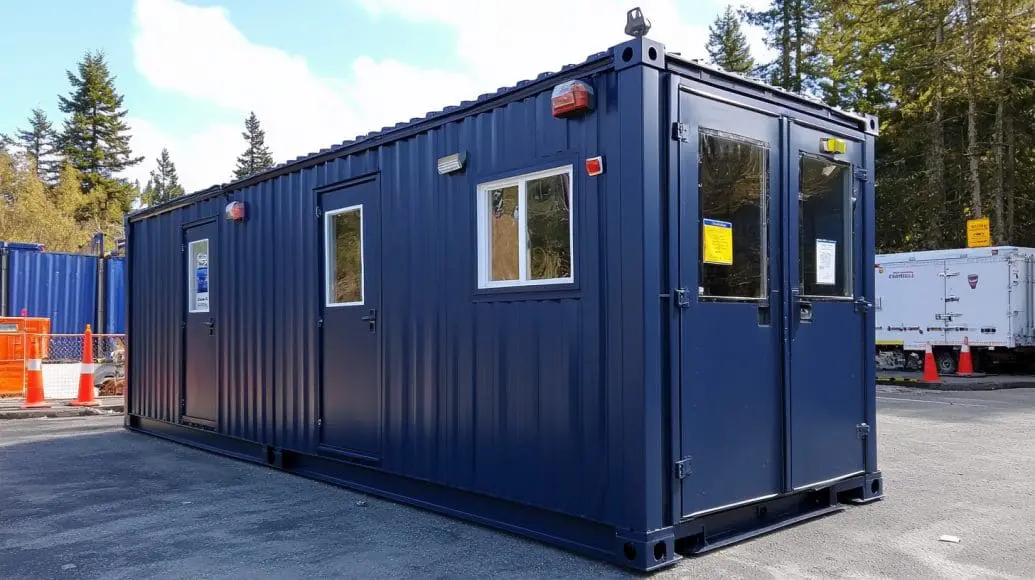
Introduction to Porta Cabin Costs in 2024
Understanding porta cabin costs in 2024 is crucial for anyone planning to invest in these versatile structures. Porta cabins are gaining popularity because of their cost-effectiveness and rapid installation. They serve a wide range of purposes, from temporary offices to residential units. However, as demand rises, costs can vary significantly.
Knowing what factors influence these costs can help you budget effectively and avoid unexpected expenses. This guide will cover all aspects of porta cabin costs, so you can make well-informed decisions.
Costs can vary based on factors like materials, location, and design complexity. Using expensive materials or custom designs increases the price, while choosing basic options can save money. The size and intended use of the porta cabin also influence the cost. Understanding these factors can help you budget effectively and avoid overspending.
Experts predict that the demand for porta cabins will keep increasing in 2024. Porta cabins are popular because they are versatile, affordable, and provide flexible space solutions. Understanding the trends and costs when planning small or large projects is important. This guide will help you understand porta cabin costs so you can make informed decisions for your needs. Explore a range of innovative porta cabins at SAMAN Portable Office Solutions.
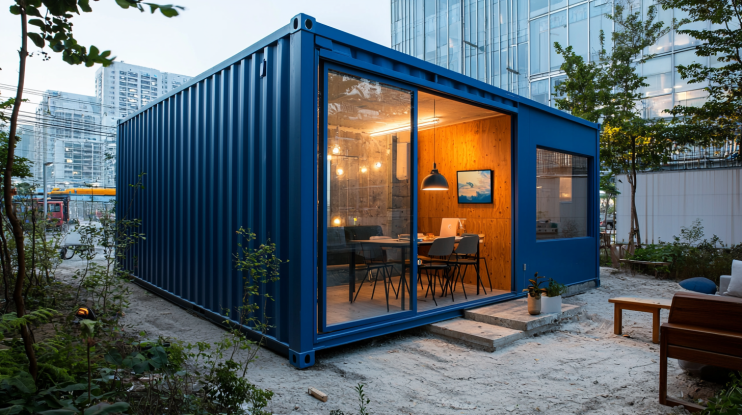
Modern blue container office at a busy urban construction site.
Porta cabin costs per square foot explained simply.
Porta cabin cost per square foot is a critical metric for anyone planning a construction project. This measure allows you to estimate the total cost of a cabin based on its size and the specific materials used.
Larger cabins are cheaper per square foot because they spread out costs like site preparation over a bigger area. This makes them more economical for larger projects. However, smaller cabins may be more suitable for those with limited space or budget constraints.
The materials chosen for the cabin also impact the cost per square foot. Using quality materials like steel or good insulation can increase costs. Nonetheless, they have the potential to economize over an extended period. This is because they last longer and help save energy.
Choosing cheaper materials can lower initial costs, but they may need more upkeep in the long run. Understanding the trade-offs between cost and quality will help you make informed decisions about your project.
Lastly, the intended use of the cabin plays a role in determining the cost per square foot. A basic storage unit may require fewer features and materials than a cabin designed for residential or office use. Custom features like climate control and special electrical systems raise costs but are essential for some uses. Consider your reasons for needing a cabin to identify the optimal balance between cost and amenities. Explore porta cabin cost per square foot for accurate budgeting.
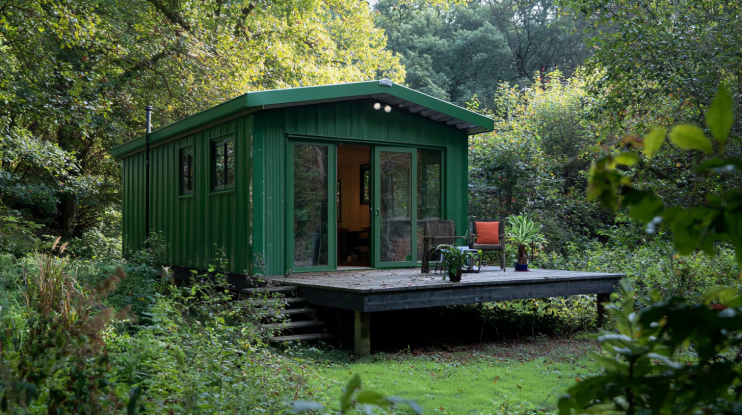
Single-storey green portable cabin with a front deck in a remote setting.
10 Key Factors Influencing Porta Cabin Costs
Several factors impact porta cabin costs. Consider each one carefully when planning your project to ensure accurate budgeting.
The type of material used affects the cost of construction. People often use steel, wood, and aluminum as materials with varying costs.
Steel is durable but expensive. Wood is cheaper but needs more maintenance. Aluminum is a good balance between cost and durability.
Location is another crucial factor. The cost of materials and labor can vary greatly depending on the location of your project. In areas with high demand for construction materials, prices may be higher. Additionally, transportation costs can add to the overall expense, especially if the installation site is far from the supplier.
Considering these regional differences when budgeting for your porta cabin is important. Choosing a nearby supplier or one in a low-cost area can help you save money on expenses.
The complexity of the design also affects the cost. A small porta cabin is usually cheaper than a large, custom-built structure with multiple rooms. Customization options, such as adding extra windows, doors, or specialized insulation, can significantly increase the cost.
However, these features can also add value, making your porta cabin more functional and comfortable. Balancing your budget with the need for these extras will help you make the best choice for your project. Learn more about the features of modern porta cabins.
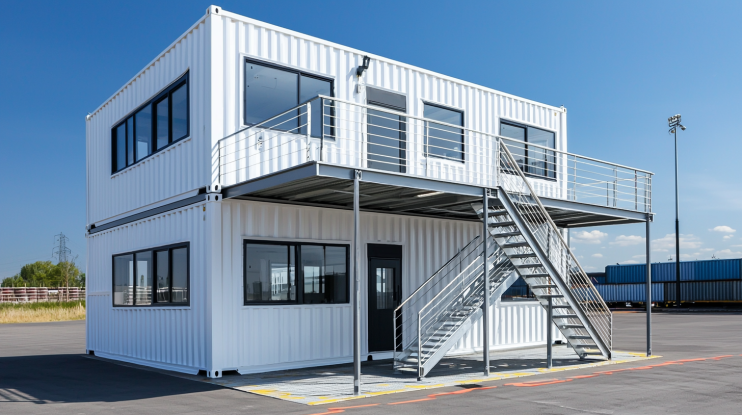
Efficient double-storey white container office in an industrial zone.
1. Material Costs: The Foundation of Porta Cabin Pricing
The materials used in constructing a porta cabin are the foundation of its overall cost. Different materials offer varying levels of durability, insulation, and aesthetic appeal, which directly influence the price. Steel is a strong and durable material, making it a great option for industrial use and long-lasting homes. However, it tends to be more expensive than other materials, reflecting its higher durability and resistance to wear.
Wood is another common material, offering a more natural appearance and often lower initial costs. However, wood requires more maintenance, particularly in regions with harsh weather conditions. This ongoing upkeep can add to the long-term costs of a porta cabin.
Aluminum is a middle-ground option, providing a balance between cost and durability. Lightweight and resistant to rust, making it a good choice for cabins in coastal or high-humidity areas.
When choosing materials, it’s essential to consider not just the initial cost but also the long-term implications. While more expensive materials may increase the upfront price, they can offer savings in maintenance and repairs over time. Conversely, cheaper materials might lower the initial investment but could lead to higher costs down the line. By understanding the pros and cons of each material, you can select the option that best suits your needs and budget. Discover top designs and material choices in porta cabins.
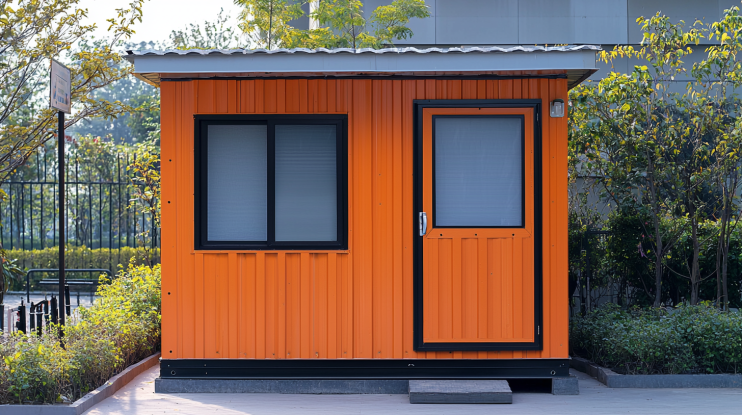
Orange portable cabin used as a security post at a gated community.
2. Standard Porta Cabin Sizes and Their Impact on Costs
The cost of a porta cabin depends on its size, with larger cabins usually costing less per square foot than smaller ones. Standard sizes range from compact 10×10 feet units to much larger 40×60 feet structures. Smaller cabins often have a higher cost per square foot. This is because fixed expenses, such as the foundation and installation, are spread over a smaller area. These units are ideal for single offices, guard rooms, or small storage spaces.
Medium-sized porta cabins, ranging from 20×30 to 30×40 feet, offer a good balance between cost and functionality. These cabins provide more space for customization and can include additional rooms or specialized features like climate control or advanced electrical systems. Because the fixed costs are distributed over a larger area, the cost per square foot tends to be lower than for smaller units, making these cabins more economical for those who need more space.
Larger porta cabins, 40×60 feet and above, generally have the lowest cost per square foot. These cabins are suitable for multi-room layouts, making them ideal for offices, classrooms, or residential use. The larger space allows for greater flexibility in design and functionality. However, while the cost per square foot decreases, the total cost of these larger cabins can be substantial. It’s essential to weigh the benefits of additional space against the overall budget to ensure the best value for your investment. Looking to buy? Check out this complete purchase guide for porta cabins.
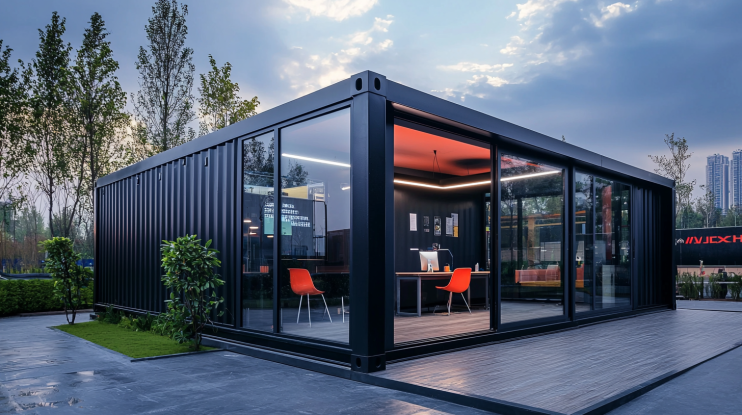
Stylish black container office in a modern tech park.
3. Customization and Its Impact on Porta Cabin Costs
Customization is a major factor that can significantly influence porta cabin costs. The ability to tailor a porta cabin to meet specific needs is one of its biggest advantages, but it also comes with added expenses. For instance, altering the interior layout to create multiple rooms or open spaces requires additional materials and labor, which will increase the overall cost. Likewise, installing high-end finishes or custom features such as advanced insulation or climate control will further raise the price.
The more customized the cabin, the higher the cost per square foot. Each addition, whether it’s extra windows, doors, or specialized equipment, requires more resources and time to implement. However, these customizations can also add significant value to the cabin, making it more functional and comfortable for its intended use. It’s important to carefully consider which customizations are necessary and which can be omitted to keep costs within your budget.
Balancing the desire for customization with budget constraints is essential. While it might be tempting to include a wide range of custom features, each addition contributes to the total cost per square foot. By focusing on the essential features and opting for more affordable materials where possible, you can create a customized porta cabin that fits your budget while still meeting your functional requirements. This approach ensures that you get the best value for your investment. Explore customization options with luxury porta cabins.
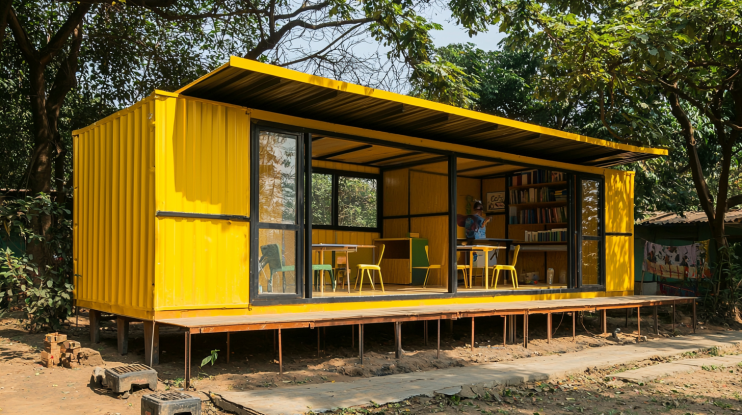
Yellow portable cabin used as a classroom in a rural school.
4. The Role of Insulation and Climate Control in Determining Porta Cabin Costs
Insulation and climate control are crucial factors that significantly affect porta cabin costs. Proper insulation is essential for maintaining a comfortable indoor environment, especially in regions with extreme temperatures. It reduces the need for heating and cooling, leading to long-term energy savings. However, high-quality insulation materials, such as spray foam or insulated panels, can increase the initial cost per square foot.
The choice of insulation depends on the intended use of the porta cabin. For example, basic insulation materials like fiberglass are cost-effective and provide adequate thermal protection in moderate climates. However, in areas with extreme weather conditions, advanced insulation may be necessary to ensure comfort and energy efficiency. These materials, while more expensive, offer better long-term savings by reducing energy consumption.
Climate control systems, such as heating, ventilation, and air conditioning (HVAC), also impact the overall cost. Installing these systems can significantly increase the cost per square foot, particularly if high-efficiency or advanced units are chosen. However, the benefits of a well-regulated indoor climate, such as improved comfort and reduced energy bills, often justify the higher initial investment. By carefully considering the role of insulation and climate control, you can create a porta cabin that is both comfortable and cost-effective. See how modular porta cabins integrate climate control features.
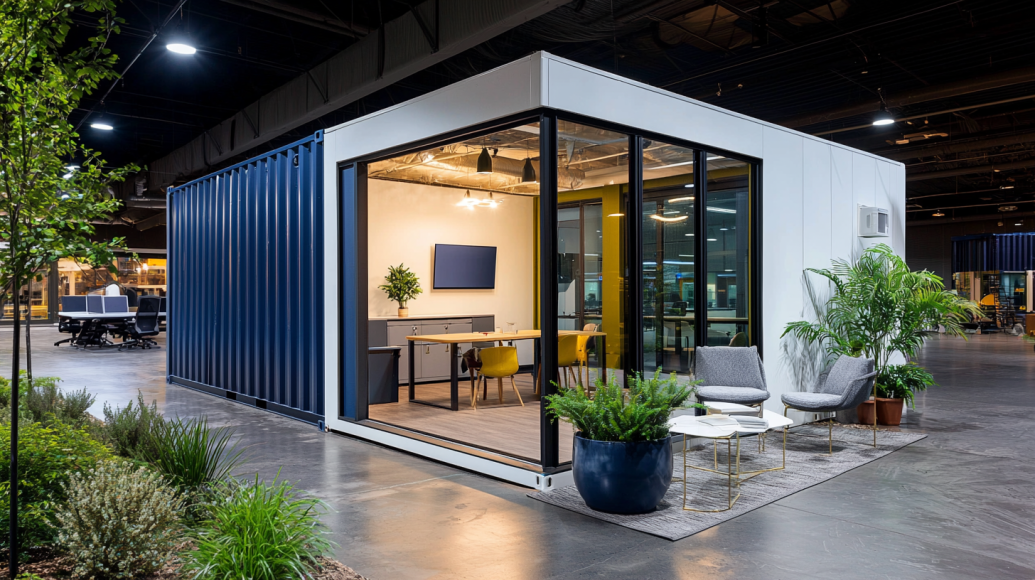
L-shaped container office with conference room in corporate park.
5. Site Preparation and Foundation Costs
The foundation and site preparation are critical elements that directly impact porta cabin costs. Before a porta cabin can be installed, the site must be properly prepared, and the foundation must be laid. The type of foundation required depends on various factors, including the soil conditions, the size of the cabin, and local building codes. These preparations are essential to ensure the stability and longevity of the porta cabin but can add to the overall cost.
Site preparation typically involves clearing the land, leveling the ground, and addressing any drainage issues. In some cases, more extensive work may be required, such as grading a sloped site or removing obstacles like rocks or trees. The cost of these tasks can vary widely depending on the condition of the site and the complexity of the work needed. In addition, the type of foundation chosen—whether it’s a simple gravel base or a more robust concrete slab—will also influence the cost per square foot.
Proper planning for foundation and site preparation is crucial to avoid unexpected expenses. Working with a local contractor who understands the specific requirements of your site can help you determine the most cost-effective solution. By ensuring that the foundation is appropriate for the size and use of the porta cabin, you can prevent future issues and protect your investment. Accurately estimating these costs during the planning phase will give you a clearer picture of the overall cost per square foot and help you stay within your budget. Find out why porta cabins are the best option for various terrains.
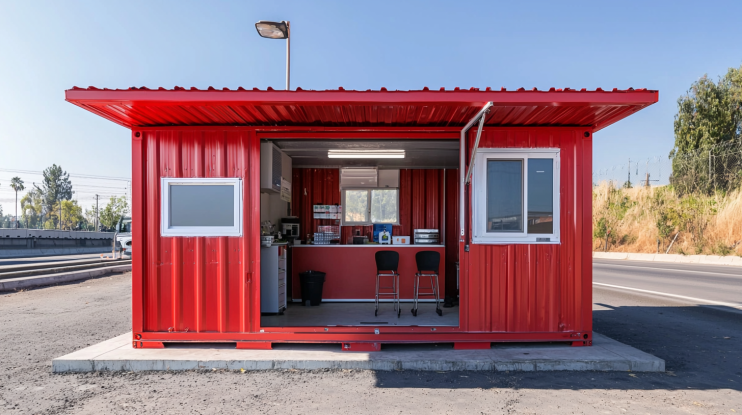
Red portable cabin repurposed as a medical clinic near a highway.
6. Utility Installation: Plumbing and Electrical Costs
Utility installation, including plumbing and electrical systems, is a significant factor in determining porta cabin costs. These systems are essential for making the porta cabin fully functional, whether it’s used for residential, commercial, or industrial purposes. The complexity of the installation will depend on the specific requirements of the cabin, such as the number of electrical outlets needed or the extent of the plumbing work required.
Electrical installation typically involves wiring the cabin for lights, outlets, and other electrical needs. The number of outlets and the type of lighting fixtures installed will influence the cost. In addition, any specialized wiring for data connections, security systems, or high-capacity power supplies can add to the overall expense. For example, a basic office setup may require only a few outlets and lights, while a residential cabin might need a more extensive electrical system to accommodate kitchen appliances, heating, and cooling systems.
Plumbing installation costs are determined by factors such as the proximity to existing water and sewage lines, the number and type of fixtures required, and the materials used. For instance, installing a simple restroom might be relatively affordable, but adding a kitchen, laundry facilities, or multiple bathrooms will increase the cost per square foot. These systems must also comply with local building codes, which can add to the complexity and cost of the installation. Planning the utility installation carefully and working with experienced contractors can help you manage these costs while ensuring that the porta cabin meets all functional requirements. Compare porta cabins with traditional building setups.
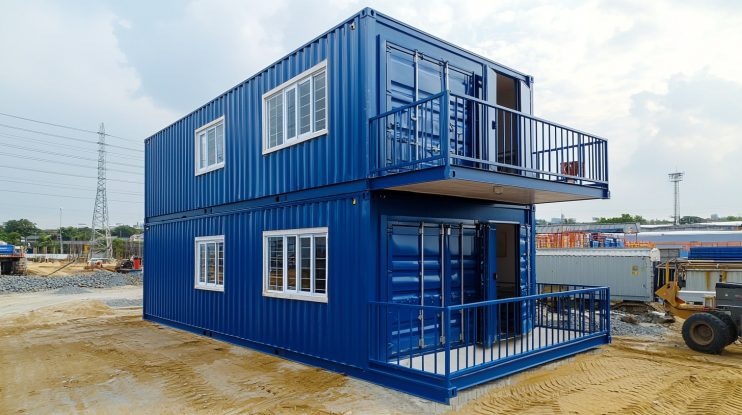
Double-storey container office used for project management.
7. Transportation and Delivery Costs
Transportation and delivery are important considerations that can significantly influence porta cabin costs. The cost of transporting a porta cabin from the manufacturing site to the installation location depends on several factors, including the distance, the size and weight of the cabin, and the accessibility of the site. These costs can add up, particularly if the cabin needs to be transported over long distances or to a remote or difficult-to-access location.
- Distance from Manufacturing Site: The further the cabin needs to be transported, the higher the cost. This is due to fuel, labor, and time expenses.
- Size and Weight of the Cabin: Larger or heavier cabins may require specialized vehicles or equipment for delivery, increasing transportation costs.
- Site Accessibility: If the installation site is hard to reach, such as in remote areas, additional costs may arise for special permits, escorts, or last-minute route changes.
Choosing a supplier located closer to the installation site can help minimize transportation costs. Local suppliers often have lower delivery fees and may offer additional services, such as site preparation or installation, as part of the package. Additionally, planning the logistics of the delivery carefully can help avoid unexpected expenses, such as additional charges for difficult terrain or last-minute changes in the delivery route. By considering these factors during the planning phase, you can ensure that the transportation and delivery costs are factored into the overall cost per square foot, helping you stay within your budget. Explore porta cabin cost per square foot for accurate budgeting.
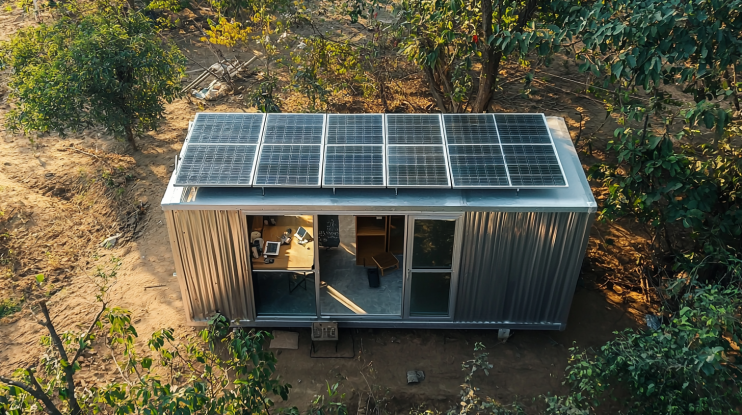
Eco-friendly silver portable cabin with solar panels in rural area.
8. Labor Costs and Installation Fees
Labor costs and installation fees are key components that significantly affect porta cabin costs. These costs encompass the expenses associated with assembling and setting up the porta cabin on-site, including the work of skilled laborers, electricians, plumbers, and other professionals. The complexity of the installation, the size of the cabin, and the specific features being integrated all contribute to the amount of labor required, which in turn influences the total cost.
Labor rates can vary widely depending on the region. In areas where the cost of living is higher, labor costs are typically more expensive, which increases the overall installation fees. Conversely, in regions where labor is more affordable, you might see a reduction in the total cost per square foot. The level of expertise required for the installation also plays a role; more complex projects that involve specialized labor, such as advanced electrical or plumbing work, will naturally incur higher costs.
Installation fees are influenced not only by labor rates but also by the specific requirements of the project. For example, installing a basic porta cabin on a pre-prepared site may be relatively straightforward and less expensive. However, if the installation involves more complex tasks, such as integrating multiple rooms, advanced utilities, or dealing with challenging site conditions, the costs can rise significantly. By obtaining detailed quotes and understanding what is included in the installation fees, you can better manage these costs and avoid unexpected expenses, ensuring that the cost per square foot remains within your budget. Find the best porta cabins near you.
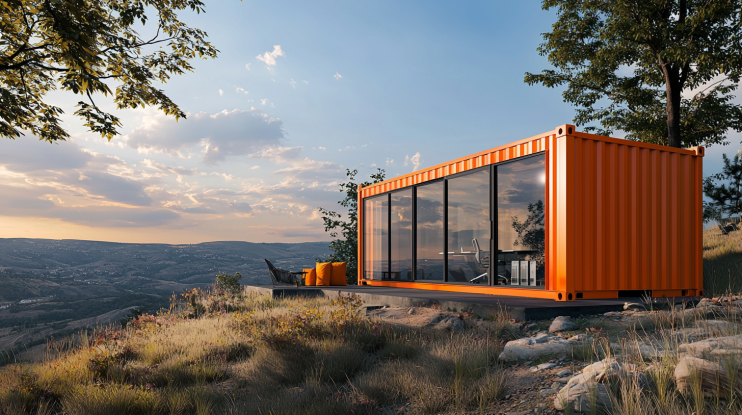
Orange container office with scenic valley view.
9. Comparing Prefabricated vs. On-Site Construction Costs
When evaluating porta cabin costs, it’s important to compare the costs associated with prefabricated versus on-site construction. Prefabricated porta cabins are built in a controlled factory environment and then transported to the installation site for assembly. This method often results in lower costs per square foot due to the efficiency of factory production, reduced labor costs, and minimized waste. Additionally, prefabricated cabins typically have shorter construction timelines, which can lead to savings on both labor and financing costs.
On-site construction, where the cabin is built directly at the project location, offers greater flexibility in design and customization. However, this method can be more expensive due to the extended construction time and the potential for delays caused by weather, labor availability, or other unforeseen factors. On-site construction also tends to involve higher labor costs, especially in regions with expensive labor markets, which further increases the overall cost per square foot.
Choosing between prefabricated and on-site construction depends on the specific needs and constraints of your project. If you prioritize cost efficiency and speed, prefabricated porta cabins are likely the better option, providing a lower cost per square foot and faster installation. However, if you require a highly customized solution with more design flexibility, on-site construction may be worth the additional expense. Understanding the differences between these two methods will help you make an informed decision that aligns with your project goals and budget. Check out the complete guide to porta cabin pricing in 2024.
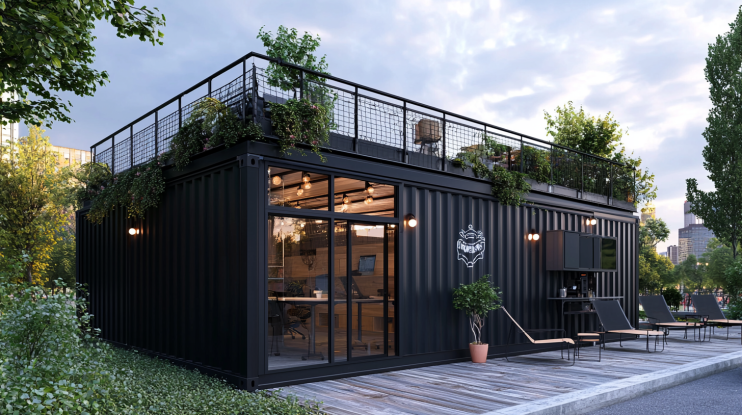
L-shaped black container office with rooftop terrace in a city.
10. Long-Term Costs: Maintenance and Upkeep
The long-term costs associated with maintaining and upkeeping a porta cabin are crucial considerations that can impact porta cabin costs over time. While the initial purchase and installation are significant expenses, the ongoing maintenance costs will affect the total cost of ownership. Regular maintenance is essential to keep the cabin in good condition, ensuring its longevity and preventing costly repairs down the line.
- Routine Maintenance: Regular cleaning, inspections for damage, and servicing of utilities like plumbing and electrical systems are necessary to maintain functionality.
- Material-Specific Upkeep: Different materials have varying maintenance needs; for example, wood requires more frequent care than steel, which is more durable.
- Potential Repairs: Over time, components may need replacing, insulation may require upgrades, or energy-efficient systems may need improvements, all adding to long-term costs.
In addition to routine maintenance, it’s important to budget for potential repairs or upgrades that may be needed as the cabin ages. This could include replacing worn-out components, upgrading insulation, or improving energy efficiency. By planning for these long-term costs, you can ensure that your porta cabin remains a valuable and functional asset for many years. Proper maintenance and upkeep will not only protect your investment but also help to maintain a lower cost per square foot over the cabin’s lifespan, making it a more economical choice in the long run. Explore premium portable solutions for long-term investments.
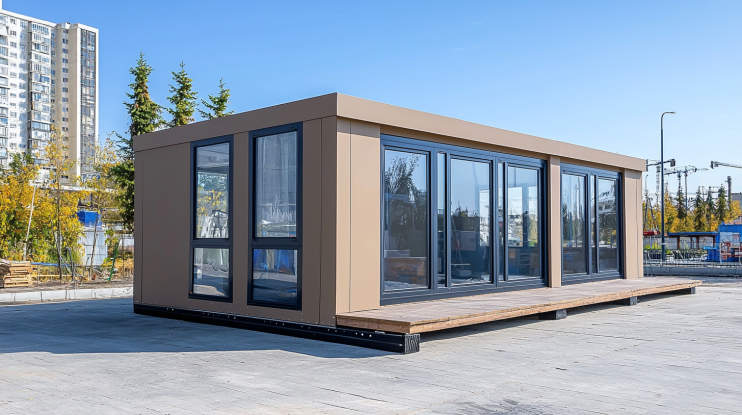
Beige portable cabin functioning as a sales office.
Regional Variations in Porta Cabin Costs
The porta cabin costs can vary significantly depending on the region where the cabin is being constructed and installed. These regional differences are often influenced by factors such as the cost of materials, labor rates, transportation expenses, and local regulations. For example, in areas where building materials are scarce or in high demand, the cost per square foot for a porta cabin will naturally be higher. Similarly, labor rates can vary widely depending on the local economy; areas with a higher cost of living generally have higher labor costs, which contributes to the total expense.
Transportation costs are another factor that can significantly impact regional variations in cost. If the porta cabin needs to be transported over long distances, especially to remote or difficult-to-access locations, the delivery costs will increase, raising the overall cost per square foot. In contrast, regions with abundant local suppliers may benefit from lower transportation costs, resulting in more competitive pricing for the end-user.
Local building regulations and zoning laws can further affect the cost per square foot. In some regions, stricter regulations may require additional modifications or permits, adding to the overall cost. For example, areas prone to natural disasters like earthquakes or hurricanes may have specific building codes that require reinforced structures or additional safety features, which can increase the price. Understanding these regional variations is crucial for accurately estimating the cost of your porta cabin and ensuring that it meets all local requirements, helping you to budget more effectively for your project. Learn more about how regional factors impact porta cabin costs.
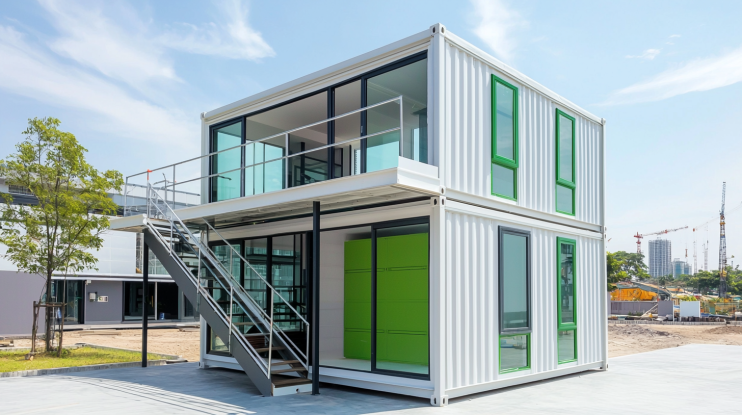
White double-storey container office at coastal site.
Financing Options and Their Impact on Porta Cabin Costs
Financing plays a significant role in determining porta cabin costs. Several financing options are available for those looking to invest in porta cabins, each with its own impact on the overall cost. The choice of financing can affect not only the initial outlay but also the long-term cost per square foot, depending on the terms of the loan, interest rates, and repayment schedule.
One common financing option is taking out a traditional bank loan. This method often involves fixed or variable interest rates, with repayment periods that can range from a few years to several decades. While bank loans provide the advantage of predictable monthly payments, the interest paid over time can significantly increase the total cost per square foot. It’s important to compare loan options and interest rates to find the most cost-effective solution for your budget.
Leasing is another financing option, particularly appealing for projects where the porta cabin is only needed temporarily. Leasing spreads the cost over time, reducing the initial financial burden. Additionally, some leasing agreements include maintenance and service costs, which can help lower the overall expense. However, leasing may end up being more expensive in the long run, especially if you decide to purchase the cabin at the end of the lease term.
For those looking to finance their porta cabin through alternative means, specialized lenders offer loans tailored specifically for modular buildings and portable structures. These lenders may provide more flexible terms or lower interest rates compared to traditional banks. Additionally, some suppliers offer in-house financing options or partnerships with financial institutions to provide their customers with convenient payment plans. Exploring all available financing options will help you find the best solution for your budget and project needs, ultimately influencing the cost per square foot. Find expert advice for financing your porta cabin purchase.
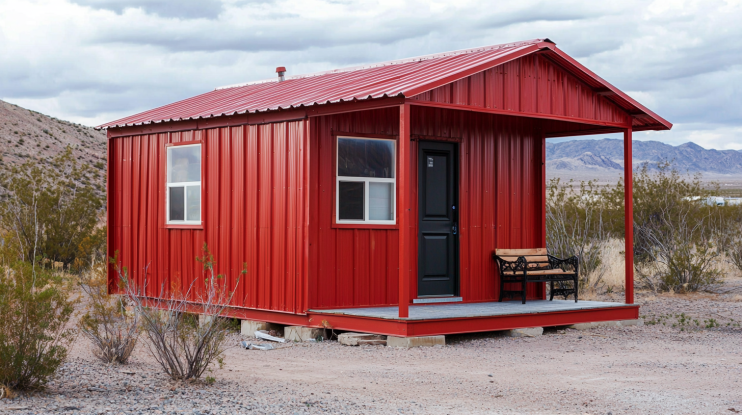
Red portable cabin serving as a site office in a desert mining project.
Cost Breakdown by Usage Type: How Purpose Affects Porta Cabin Costs
Porta cabin costs can vary significantly depending on the intended usage of the cabin. Whether the cabin is used for residential, commercial, or industrial purposes, each application has specific requirements that influence the overall cost. Understanding how these factors affect the cost per square foot is essential for accurate budgeting and planning.
Residential porta cabins typically require more amenities, such as kitchens, bathrooms, and sleeping areas, which increase the cost per square foot. Additionally, residential cabins often need more insulation and climate control features to ensure comfort, particularly in areas with extreme temperatures. These additional features, while necessary for creating a livable space, contribute to the higher cost per square foot compared to other usage types.
Commercial porta cabins are often used as office spaces, retail stores, or temporary classrooms. These cabins usually require extensive electrical wiring, data connections, and specialized layouts to accommodate business needs. The cost per square foot for commercial cabins can be higher due to the need for these additional features. However, the efficiency and quick installation of porta cabins make them an attractive option for businesses looking to expand or set up temporary locations.
Industrial porta cabins, used for purposes such as storage, workshops, or on-site accommodations for workers, often require reinforced structures and specialized equipment to meet safety and operational standards. These cabins may also need heavy-duty utilities and more robust materials to withstand harsh working environments. As a result, the cost per square foot for industrial porta cabins tends to be higher compared to residential or commercial options. By understanding the specific requirements for each usage type, you can accurately estimate the costs and choose the right cabin for your needs.
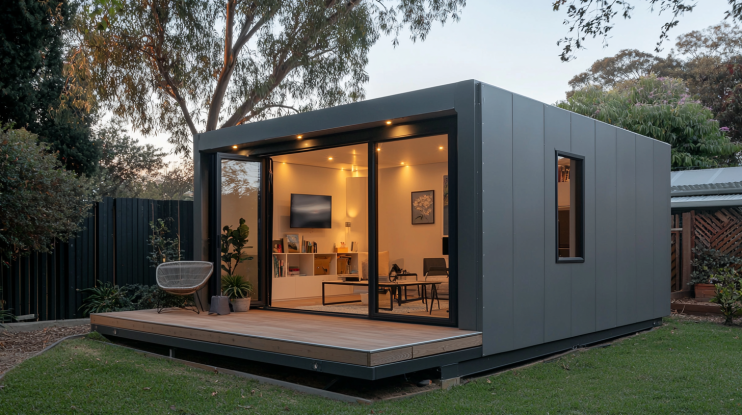
Grey portable cabin transformed into a suburban artist’s studio.
Sustainability Features and Their Influence on Porta Cabin Costs
Sustainability is becoming increasingly important in construction, and porta cabins are no exception. Incorporating sustainability features into a porta cabin can affect porta cabin costs, but these features often provide long-term benefits that outweigh the initial investment. Sustainable porta cabins are designed to reduce environmental impact through the use of energy-efficient materials, renewable energy sources, and eco-friendly construction practices.
Energy-efficient insulation is one of the most common sustainability features in porta cabins. Proper insulation reduces the need for heating and cooling, lowering energy consumption and costs. While the initial investment in high-quality insulation may increase the cost per square foot, the long-term savings on energy bills make it a cost-effective choice. Similarly, installing solar panels allows the cabin to generate its own electricity, further reducing reliance on external power sources and lowering energy costs over time.
The use of recycled or eco-friendly materials in construction also contributes to sustainability. These materials, while often more expensive, have a lower environmental footprint compared to traditional materials. For example, recycled steel or sustainably sourced wood can be used to construct the cabin, reducing the demand for new raw materials. Incorporating these materials into the design of the porta cabin not only supports environmental sustainability but can also enhance the cabin’s appeal to environmentally conscious buyers, potentially increasing its resale value.
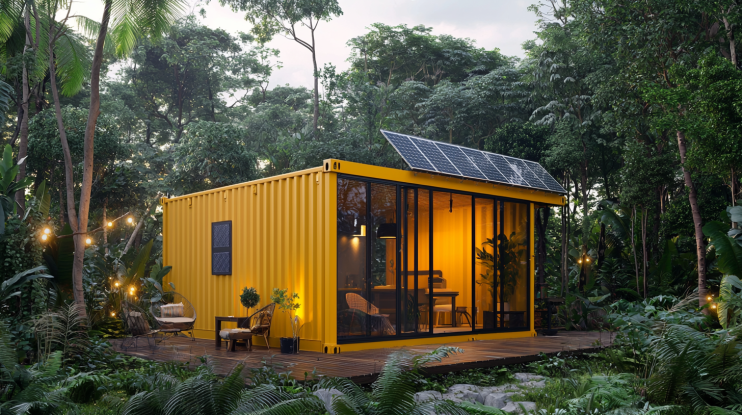
Yellow container office with solar lighting at an eco-friendly resort
Understanding the ROI of Porta Cabins Based on Porta Cabin Costs
Understanding the return on investment (ROI) for porta cabins is essential when evaluating porta cabin costs. ROI is influenced by several factors, including the initial cost, ongoing maintenance expenses, and the revenue or savings generated by the cabin. For example, if a porta cabin is used as a rental property or a commercial space, the income generated from tenants or business operations can significantly impact the ROI.
- Initial Costs: These include purchase price, installation, and customization expenses, which form the baseline for calculating ROI.
- Ongoing Maintenance: Regular upkeep is necessary to preserve the cabin’s value and functionality, affecting long-term ROI.
- Revenue Generation: Income from renting or using the cabin for business purposes can enhance ROI, making it a profitable investment.
To calculate the ROI, start by determining the total cost of the porta cabin, including purchase, installation, and any additional features or customizations. Next, estimate the potential revenue or savings generated by the cabin over time. This could include rental income, operational savings, or increased productivity due to the convenience and flexibility of the cabin. By comparing the total cost to the expected revenue or savings, you can calculate the ROI and determine whether the investment is worthwhile.
Additionally, the resale value of the porta cabin can contribute to the overall ROI. Porta cabins that are well-maintained and include desirable features such as energy-efficient systems or modern amenities may retain their value better and be easier to sell in the future. Understanding the factors that influence ROI will help you make informed decisions when purchasing and using a porta cabin, ensuring that your investment delivers the maximum possible return.
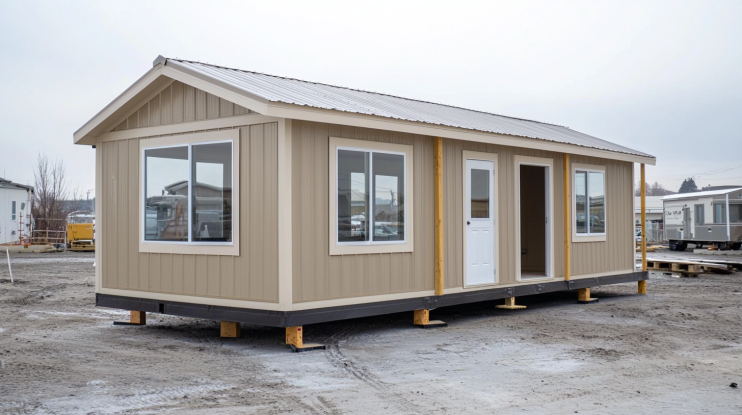
This porta Cabin designed and manufactured by SAMAN
Case Studies: Real-World Examples of Porta Cabin Costs
Real-world case studies provide valuable insights into the actual costs and benefits of using porta cabins in various scenarios. Examining these examples helps potential buyers understand how porta cabin costs play out in different applications, from commercial projects to residential or industrial uses. These case studies demonstrate how different factors, such as location, customization, and usage, can influence the overall cost.
One case study might focus on a construction company that used porta cabins as temporary on-site offices. The company was able to set up fully functional workspaces quickly and at a lower cost per square foot compared to traditional construction. The portability of the cabins allowed them to be relocated as needed, further enhancing their value to the project. This flexibility helped the company reduce overall project costs while maintaining productivity.
Another case study could highlight a school district that used porta cabins to address classroom overcrowding. By choosing prefabricated porta cabins, the district was able to add additional classrooms within a tight budget and timeframe. The cabins were customized to include essential features such as HVAC systems, electrical wiring, and secure entry points, providing a safe and comfortable learning environment. This solution not only met the immediate needs of the district but also offered flexibility for future expansion or reconfiguration.
A third case study might explore the use of porta cabins in disaster relief efforts. In this scenario, porta cabins were deployed to provide temporary housing for displaced families. The cabins were chosen for their quick installation, affordability, and ability to withstand harsh conditions. By analyzing these case studies, potential buyers can gain a better understanding of how porta cabins can be used effectively in different situations, what costs to expect, and how to maximize the benefits of their investment.
Future Trends Impacting Porta Cabin Costs
The future of porta cabins is shaped by several emerging trends that are expected to influence porta cabin costs. As the demand for portable and modular structures continues to grow, advancements in technology, sustainability, and design are likely to play a significant role in determining future costs. Staying informed about these trends can help buyers make strategic decisions and optimize their investment in porta cabins.
One of the most significant trends is the integration of smart technology into porta cabins. As more industries adopt smart systems, porta cabins are likely to include features such as automated climate control, smart lighting, and advanced security systems. These technologies not only enhance the functionality of the cabins but also improve energy efficiency, making them more appealing to businesses and homeowners alike. However, the inclusion of smart technology may increase the initial cost per square foot, though the long-term benefits could outweigh the initial investment.
Sustainability will continue to be a major focus in porta cabin design. With increasing awareness of environmental issues, there is a growing demand for eco-friendly construction methods and materials. Future porta cabins may incorporate more recycled materials, energy-efficient designs, and renewable energy sources like solar panels. Additionally, the trend towards modular construction is expected to grow, allowing for greater flexibility and scalability. This modular approach will enable users to easily expand or reconfigure their cabins as needs change, providing a more sustainable and cost-effective solution.
Another emerging trend is the expansion of porta cabins into new markets and applications. While traditionally used for temporary offices or housing, porta cabins are now being adapted for a wide range of uses, including luxury accommodations, retail spaces, and even medical facilities. This diversification is driven by the cabins’ versatility and the increasing demand for flexible, affordable, and mobile solutions. As these trends continue to develop, porta cabins are poised to become a key player in the future of construction and urban planning.
FAQs About Porta Cabin Costs
Q1: What factors influence the cost of a porta cabin?
A1: Several factors influence the cost of a porta cabin, including the size of the cabin, materials used, level of customization, insulation and climate control features, site preparation, and transportation costs. Labor rates and the complexity of the installation can also impact the overall price.
Q2: How much does a standard porta cabin cost per square foot?
A2: The cost per square foot for a standard porta cabin can vary depending on the materials used and the level of customization. On average, you can expect to pay between ₹1200 and ₹17000 per square foot. High-end, customized cabins can exceed this range.
Q3: Are porta cabins more cost-effective than traditional buildings?
A3: Yes, porta cabins are generally more cost-effective than traditional buildings. They require less time to construct, lower labor costs, and reduced material waste. Additionally, the modular nature of porta cabins allows for flexibility in design and easy relocation, further enhancing their cost-effectiveness.
Q4: How do transportation and delivery affect porta cabin costs?
A4: Transportation and delivery can significantly affect porta cabin costs, especially if the site is remote or difficult to access. Costs include fuel, labor for loading and unloading, and any special equipment needed for transportation. Choosing a supplier closer to the installation site can help reduce these expenses.
Q5: What are the long-term costs associated with maintaining a porta cabin?
A5: Long-term costs include regular maintenance, such as inspections, repairs, and potential upgrades to insulation or utilities. While porta cabins are designed to be durable and low-maintenance, proper upkeep is essential to ensure longevity and prevent costly repairs.
Q6: Can I customize my porta cabin without significantly increasing the cost?
A6: Yes, customization options are available at various price points. While adding features like extra rooms, specialized insulation, or high-end finishes will increase the cost, many suppliers offer affordable customization options that can be tailored to your budget.
Q7: How do regional factors impact the cost of a porta cabin?
A7: Regional factors such as local labor rates, material availability, and building regulations can affect the cost of a porta cabin. In areas with higher living costs or stricter building codes, prices may be higher. Additionally, transportation costs can vary depending on the distance from the supplier.
Q8: Are there financing options available for purchasing a porta cabin?
A8: Yes, many suppliers offer financing options, including loans and leasing agreements. Financing can help spread the cost over time, making it easier to budget for your porta cabin. Be sure to compare different financing options to find the most cost-effective solution for your needs.
Q9: How quickly can a porta cabin be installed, and does the speed affect the cost?
A9: Porta cabins can typically be installed within a few days to a few weeks, depending on the complexity of the project and site conditions. Faster installation times can reduce labor costs, but expedited services or additional labor may increase the overall cost.
Q10: What are the benefits of using a prefabricated porta cabin versus building on-site?
A10: Prefabricated porta cabins offer several benefits, including lower costs, faster construction times, and less material waste. They are built in a controlled environment, which reduces the likelihood of delays due to weather or other site-related issues. Additionally, prefabricated cabins can be easily relocated or expanded as needed.
 Container Cafe
Container Cafe
















































































